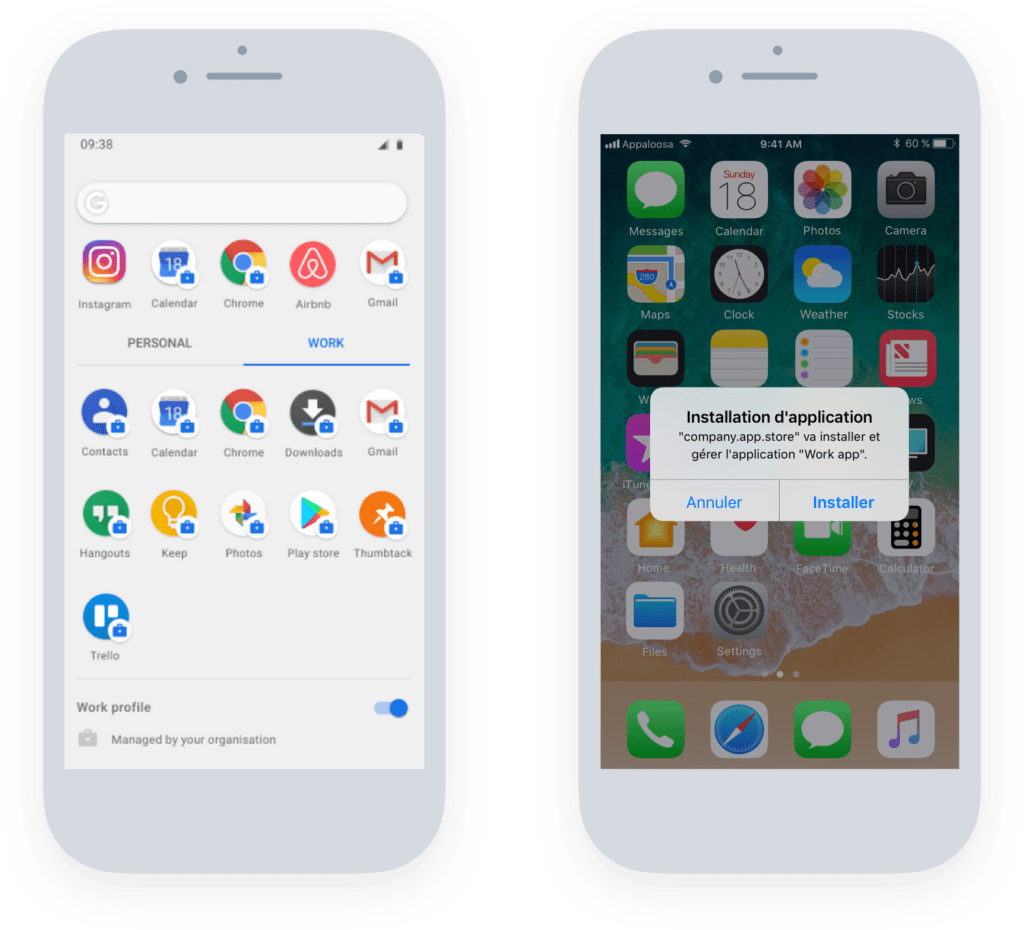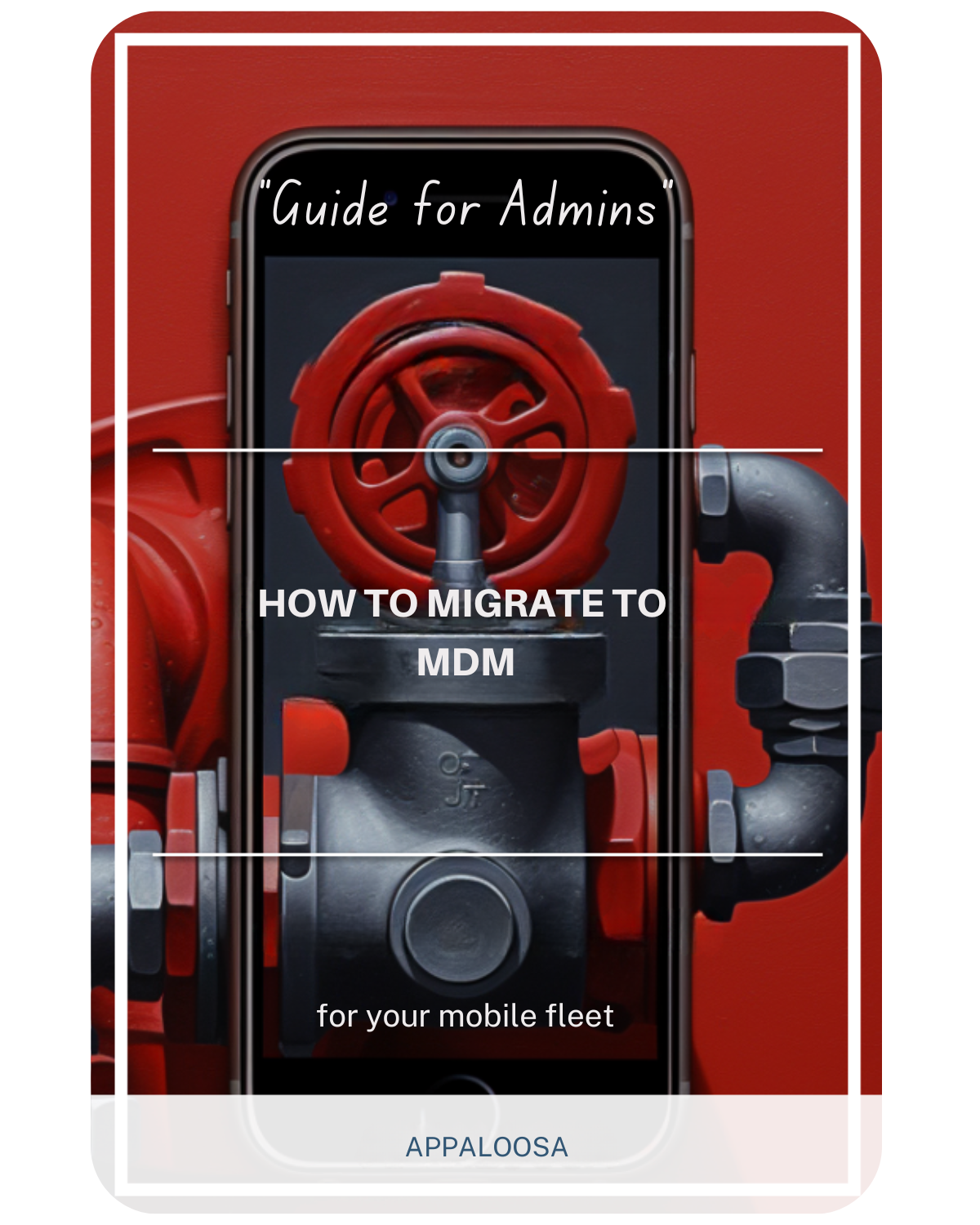What is Enterprise Mobility Management (EMM) ?

In today's mobile-first business environment, organizations face the complex challenge of enabling workforce productivity while maintaining robust security.
Enterprise mobility management has emerged as the critical solution that allows businesses to securely manage their mobile ecosystem without compromising security or employee flexibility.
Understanding Enterprise Mobility Management
What is EMM?
Mobile enterprise management, commonly known as EMM, represents a comprehensive approach to managing and securing mobile devices, applications, and content within an organization.
EMM software provides IT departments with the tools necessary to manage mobile devices across diverse platforms while protecting sensitive information and maintaining compliance with regulatory requirements.
At its core, EMM mobile technology enables organizations to embrace mobility while maintaining control over corporate data.
This endpoint mobility management approach has become essential as businesses navigate the complexities of modern work environments, where employees expect seamless user experiences across multiple devices and locations.
A well-defined enterprise mobile strategy ensures that organizations can leverage mobility effectively while maintaining security standards.
The Evolution from MDM to EMM to UEM
The journey of enterprise mobility began with mobile device management MDM, which focused primarily on device-level control and security.
However, as mobile usage evolved beyond simple device management, organizations required more sophisticated solutions.
This need drove the evolution toward comprehensive EMM service platforms that encompass not just devices but also applications, content, and identity management.
Today, EMM has further evolved into unified endpoint management UEM, reflecting the convergence of mobile and traditional endpoint management.
After Microsoft's 2015 release of Windows 10, most EMM vendors expanded their capabilities to manage PCs alongside mobile devices, creating truly unified management platforms.

Components of EMM
Core Technologies
The components of EMM work together to create a comprehensive security and management framework:
Mobile Device Management (MDM) forms the foundation of any EMM solution. It provides device-level control through agent applications that enforce security policies and configurations.
MDM enables remote management capabilities including device lock, wipe, and reset functions to protect corporate data when devices are lost or stolen.
Mobile Application Management (MAM) offers granular control over specific applications rather than entire devices.
This component is particularly valuable in bring your own device scenarios where organizations need to secure corporate mobile apps and enterprise apps without affecting personal data on employee-owned devices.
MAM ensures that each mobile app accessing corporate resources adheres to security policies.
Mobile Content Management (MCM) controls how corporate content is accessed, shared, and stored on mobile devices.
It ensures that sensitive information remains protected through encryption and access controls while enabling productive collaboration.
Identity and Access Management (IAM) provides authentication and authorization services, often including single sign-on capabilities and multi-factor authentication.
This component ensures that only authorized users can access corporate resources and enterprise apps, regardless of the device they're using.
Integration and Deployment
Modern EMM tools integrate these components into unified platforms that provide centralized management consoles.
Through these consoles, IT administrators can set policies, deploy software updates, monitor compliance, and respond to security incidents across the entire mobile fleet.
The integration of these components creates synergies that enhance both security and usability.
For example, MAM can leverage IAM for authentication while MCM uses MDM's encryption capabilities to protect data at rest.
Benefits of Implementing EMM
Enhanced Security
Device security represents the primary driver for EMM adoption. Organizations gain improved security through multiple layers of protection:
- Data encryption for information at rest and in transit
- Remote wipe capabilities for lost or stolen devices
- Application sandboxing to prevent data leakage between mobile apps
- Network access controls and VPN enforcement
- Compliance monitoring and automated remediation
These security features work together to create a comprehensive defense against both external threats and insider risks, ensuring that corporate data remains protected regardless of where or how it's accessed.
Increased Productivity
EMM software enhances productivity by providing employees with secure, seamless access to corporate resources and enterprise apps. Users can work effectively from any location using their preferred devices, while IT maintains control over security and compliance. Key productivity benefits include:
- Automated application deployment and updates for mobile apps
- Self-service portals for common IT requests
- Streamlined onboarding processes for new devices
- Consistent user experiences across platforms
- Reduced downtime through proactive management
Cost Optimization
Organizations implementing EMM typically experience significant cost savings through:
- Reduced IT support tickets and manual interventions
- Lower hardware costs through device BYOD programs
- Decreased security incident expenses
- Improved license management and software utilization for enterprise apps
- Streamlined compliance and audit processes
The automation capabilities of modern EMM service platforms dramatically reduce the time IT teams spend on routine tasks, allowing them to focus on strategic initiatives.
Implementing EMM Successfully
Planning Your EMM Strategy
Successful EMM implementation begins with comprehensive planning and a clear mobility strategy. Organizations must assess their current mobile landscape, identify security requirements, and establish clear policies before deployment. Key planning considerations include:
Device Strategy: Determine whether to implement corporate-owned devices, bring your own device programs, or a hybrid approach. Each model has implications for security, cost, and user satisfaction.
Security Requirements: Identify specific security needs based on industry regulations, data sensitivity, and risk tolerance. This assessment guides policy development and technology selection as part of your broader enterprise mobile strategy.
User Experience Goals: Balance security requirements with usability to ensure employee adoption and productivity. Overly restrictive policies can lead to shadow IT and reduced effectiveness.
Choosing the Right EMM Tools
Selecting appropriate EMM tools requires careful evaluation of multiple factors:
Platform Support: Ensure the solution supports all operating systems and device types used within your organization. Cross-platform consistency is crucial for effective management of mobile apps and enterprise apps.
Integration Capabilities: Evaluate how well the EMM platform integrates with existing IT infrastructure, including directory services, email systems, and security tools.
Scalability: Choose solutions that can grow with your organization, supporting increasing numbers of devices and evolving use cases without requiring platform changes.
Vendor Support: Consider the quality of vendor support, including implementation assistance, ongoing technical support, and training resources.
Deployment Best Practices
Successful EMM deployment requires a phased approach that minimizes disruption while ensuring comprehensive coverage:
Pilot Programs: Start with a small group of users to validate policies and procedures before full rollout. This approach allows refinement based on real-world feedback.
User Training: Provide comprehensive training to ensure users understand both the benefits and responsibilities of the EMM program. Clear communication reduces resistance and improves compliance.
Policy Development: Create clear, written policies that address acceptable use, security requirements, and privacy protections. Regular policy reviews ensure continued relevance.
Continuous Monitoring: Implement ongoing monitoring and optimization processes to identify issues, improve performance, and adapt to changing requirements.
Managing BYOD Environments
The BYOD Challenge
Bring your own device programs present unique challenges for mobile enterprise management. Organizations must balance employee privacy expectations with corporate security requirements while managing diverse device types and ownership models.
The key to successful device BYOD management lies in containerization technologies that separate corporate and personal data. This approach allows organizations to securely manage corporate information and enterprise apps without accessing personal applications or data.
Privacy Considerations
Respecting employee privacy in BYOD environments requires careful policy development and technology implementation. EMM mobile solutions must clearly delineate between corporate and personal data, ensuring that IT administrators cannot access personal information while maintaining security over corporate resources and mobile apps.
Transparency is crucial for BYOD success. Employees must understand what information IT can access, under what circumstances remote wipe might be used, and how their personal privacy is protected. Clear communication builds trust and encourages participation in BYOD programs.
Overcoming EMM Challenges
Technical Challenges
Organizations implementing endpoint mobility management face several technical challenges:
Compatibility Issues: Ensuring EMM solutions work seamlessly with existing infrastructure and applications requires careful planning and testing.
Integration Complexity: Connecting EMM platforms with identity providers, email systems, and other enterprise tools can be complex and time-consuming.
Performance Impact: Balancing security features with device performance and battery life requires optimization and user feedback.
Organizational Challenges
Beyond technical considerations, organizations must address several organizational challenges:
User Acceptance: Gaining user buy-in requires demonstrating value while addressing concerns about privacy and usability. Regular communication and training help overcome resistance.
Cost Management: While EMM provides long-term savings, initial implementation costs can be significant. Organizations must budget for licenses, training, and potential infrastructure upgrades.
Change Management: Transitioning to managed mobility requires cultural shifts in how organizations approach device usage and security. Strong leadership support and clear communication are essential for a successful mobility strategy.
Future Trends in Enterprise Mobility
AI and Machine Learning
The future of EMM service platforms increasingly incorporates artificial intelligence and machine learning capabilities. These technologies enable:
- Predictive threat detection and automated response
- Intelligent policy recommendations based on usage patterns
- Automated compliance monitoring and remediation
- Enhanced user behavior analytics for security
Zero Trust Security
EMM platforms are evolving to support zero trust security models that verify every access request regardless of device or location. This approach provides superior protection for sensitive information in an era of sophisticated cyber threats.
Edge Computing
As edge computing becomes more prevalent, EMM software must adapt to manage devices that process data locally rather than in centralized locations. This shift requires new approaches to security, updates, and monitoring.
Best Practices for EMM Success
Security Best Practices
- Implement multi-factor authentication for all corporate access
- Regular software updates and patch management for all mobile apps
- Encryption for data at rest and in transit
- Regular security assessments and penetration testing
- Incident response planning and testing
Management Best Practices
- Clear policies and procedures documented and communicated
- Regular training for both IT staff and end users
- Metrics-driven optimization and improvement
- Vendor relationship management and support optimization
- Regular review and updates of EMM strategies and enterprise mobile strategy
User Experience Best Practices
- Self-service portals for common requests
- Minimal impact on device performance
- Clear communication about policies and changes
- Regular feedback collection and action
- Recognition programs for security compliance
Conclusion
Enterprise mobility management has evolved from a simple device management tool to a comprehensive platform that enables secure, productive mobile work.
As organizations continue to embrace mobility, the importance of robust EMM tools that can enforce security while delivering excellent user experiences will only increase.
Success with EMM requires more than just technology implementation. Organizations must develop comprehensive strategies that address security, usability, and operational requirements while respecting employee privacy and maintaining flexibility for future growth.
A well-crafted mobility strategy ensures that enterprise apps and mobile apps work harmoniously within the corporate ecosystem.
By implementing EMM effectively, organizations can confidently embrace mobility, knowing that their data remains secure, their users remain productive, and their IT teams can efficiently manage the growing complexity of the mobile ecosystem.
The investment in EMM represents not just protection against current threats but preparation for the mobile-first future of work.
Whether starting fresh or optimizing existing deployments, the key to EMM success lies in balancing security with usability, automation with control, and standardization with flexibility.
Organizations that master this balance will be best positioned to capitalize on the opportunities that mobility presents while managing its inherent risks.


